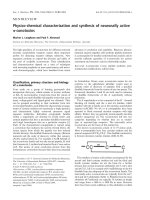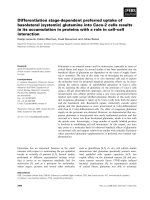Báo cáo khoa học: "Metaphor Comprehension - A special mode of language pptx
Bạn đang xem bản rút gọn của tài liệu. Xem và tải ngay bản đầy đủ của tài liệu tại đây (140.87 KB, 2 trang )
Metaphor Comprehension - A special mode of language processing?
(Extended Abstract)
Jon
M. Slack
Open
University,
U.K.
The paper addresses the question of whether a
complete language understanding system requires
special procedures in order to comprehend
metaphorical language. To answer this question
it is necessary to delineate the processes
involved in metaphor comprehension and to det-
ermine the uniqueness of such processes in the
context of existing language understanding
systems.
I. DEFINING THE PROBLEM
For the purposes of this paper a metaphor is
defined as a linguistic input containing
elements which result in a mismatch at the
semantic level which the language understanding
system attempts to interpret. For example, the
sentence
Billboards are warts on the landscape . 1
results in a semantic mismatch represented by
the sentence
Billboards are not a member
of the category warts 2
which is encountered when the underlying concep-
tual.structure is built for the sentence.
However, the mismatch need not be restricted
to elements of the sa/ne sentence. Even though
the elements of a particular sentence may not
result in a semantic mismatch, the whole sent-
ence itself can be metaphorical with respect to
its linguistic context. In this case the seman-
tic mismatch is encountered when the interpret-
er has difficulty connecting the conceptual
representation of the sentence to the existing
structure representing the context.
Metaphor comprehension is defined as the proc-
ess of mapping input metaphors onto connected
conceptual representations.
A model of metaphor comprehension is defined
as the set of processes required to interpret
elements of linguistic input which semantically
mismatch their linguistic context. The mis-
matching elements are referred to as the
vehicle of the metaphor, while the linguistic
context is known as the topic of the metaphor.
2. BUILDING A MODEL OF METAPHOR COMPREHENSION
For the purposes of describing the model only
sentences which contain both the vehicle and
topic elements of the metaphor are considered.
However, the comprehension processes described
should apply to all classes of metaphor, includ-
ing copula form (e.g. The world is a chessboard~
and verb-based metaphors (e.g. His words were
dried by the sun). The model to be outlined
is based on the analysis of a large sample of
paraphrases produced by twenty subjects for a
collection of over fifty metaphors.
It is necessary to distinguish between differ-
ent types of comprehension task. Although the
comprehension processes are generally applic-
able, whether the metaphorical input is in
isolation or part of a larger linguistic input
greatly influences the choice of comprehension
strategy.
In llne with most language comprehension sys-
tems, the goal of metaphor comprehension is to
build an integrated conceptual structure but
from mismatching components. The model is
based on the notion that the existence of the
semantic mismatch makes it necessary to build
a conceptual structure which embodies all the
salient knowledge structures associated with
the vehicle element. This process is referred
to as vehicle expansion.
Briefly, the comprehension process proceeds as
follows:
The elements of the sentence are mapped onto
their dictionary entries and in attempting to
build a conceptual structure a semantic
restriction violation (semantic mismatch) is
encountered - the subject, or object, or both
do not conform to the semantic restrictions
associated with the verb. The decision of
which element represents the topic and which
the vehicle of the metaphor is usually deter-
mined by the extra-sentential context. However,
for isolated metaphors the vehicle is usually
the element which has the minimal match with
the other elements. The knowledge structures
which constitute the vehicle element concept
are temporarily built into the conceptual
structure representing the meaning of the
sentence. This generated conceptual structure
(C~S) is also connected to the topic knowledge
structures (TKS). Comprehension is complete
when the GCS and TKS are integrated into a
single conceptual structure. Vehicle expansion
generates a relatively large conceptual struct-
ure which is pruned by means of the processes
which integrate the GCS and TKS. For example,
those knowledge structures which gave rise to
the semantic mismatch are deleted from the
conceptual structure because they contradict
what is known about the topic. Metaphor
comprehension involves interpreting the GCS in
terms of the TKS. This is achieved by means of
a matching process and the comprehension
strategies described below."
The matching process searches for matching know-
ledge structures in the GCS and TKS. Various
forms of the process are considered - fuzzy
matching procedures, a spreading activation
process. The outcome of the process is typic-
ally, (a) an element of the GCS matches a low-
saliency TKS element, (b) an element of the GCS
contradicts a TKS element, or (c) a GCS element
matches nor contradicts any TKS element. Out-
come (b) prunes the GCS; outcomes (a) and (c)
connect it to the TKS.
23
In addition, certain input metaphors require
other comprehension strategies to be invoked,
such as context construction or recursive meta-
phor interpretation.
Context construction - in some cases, although
the matching procedure has constructed a number
of important connections between the GCS and
the TKS, it is necessary to search for addition-
al knowledge structures which represent context
information which was missing in the original
input. The goal of the context construction
procedure is to provide a context information
in which the GCS-TKS connections are fully
interpreted, that is, more fully integrated.
The paper discusses the conditions necessary
for the strategy to be employed.
Recursive metaphor interpretation - many of
the elements of the GCS are themselves metap~s
in that they contain implicit semantic mis-
matches. These metaphoric elements are inter-
preted as metaphor inputs thereby making the
comprehension process recursive.
Due to the limited processing capacity and
memory constraints of language understanding
systems, the metaphor comprehension process
requires a complex control structure. This
control structure governs the use of the comp-
rehension strategies and orders the vehicle
expansion and matching processes.
3. COMPARISON WITH OTHER THE?RIES
The paper compares the model of metaphor comp-
rehension with established theories of metaphor
within linguistics and psychology.
4. CONCLUSIONS
The final part of the paper examines the
relationship between metaphor comprehension
and existing language comprehension systems.
The processes which constitute the model of
metaphor comprehension are common to many
language understanding systems (Schank, Wilks,
L)IR group, etc.). The comprehension of metaphor
does not require a special set of processes to
be developed, although the comprehension
strategies may be specific to the comprehension
task. Rather, a metaphor input forces the
comprehension system to invoke a complex
control structure to cope with the larger and
richer knowledge domains which have to be
handled. The main conclusion of the paper is
that the notions of processing capacity,
memory constraints and control structure are
the most salient constructs in sLmulation
metaphor comprehension.
24









